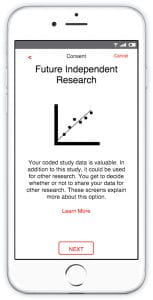Smartphones are pretty amazing, even my dinky little iPhone 5c with only 8 GB storage. In many ways they are extensions of our physical, mental, and emotional selves. Because our phones are typically either on our personage or within arm’s reach, they can track our movements and activity. This capability has made phones incredibly useful to researchers trying to understand human health and disease. For example, Seattle-based Sage Bionetworks recently completed a Parkinson’s disease study called “mPower” using a mobile phone app to track people’s symptoms. The mPower researchers were among the first to use Apple’s relatively new “Research Kit” framework, which allows research groups to design their own apps for data collection in an ongoing, real-time, and potentially massive way.
Direct-to-Researcher Genetics
While Apple’s Research Kit came out over a year ago, it was just last month that they announced a deal with direct-to-consumer genetic testing company 23andMe to enable customers to share/send their genetic data to researchers with one swipe. This set-up greases the wheels for DTC customers to become research participants and for researchers to recruit DTC customers to participate in their studies. Win-win, right? Perhaps, but my eyebrows did raise a bit when I learned that this development also means researchers can purchase 23andMe tests for their participants, essentially outsourcing the processes of informed consent, collection of biological samples, and generation of genetic data to 23andMe. These would have been expenses for the researcher regardless, but now 23andMe gets that revenue and the participant gets the 23andMe product.
Background: To return or not to return?
Relevant backstory here is that for a long time genetic researchers have struggled with if and how genetic results should be returned to research participants. There are many nuanced pros and cons, but one of the very practical cons is that there is usually no infrastructure (time, funding, people) to do it. But 23andMe has a pretty slick pipeline to give people back their genetic information, one they’ve been working on for almost a decade now. So with 23andMe’s new “direct-to-researcher” testing model (my name, not theirs), the participant gets the data they likely want and the researcher has both data and a happy participant. And 23andMe builds their revenue and their own customer database.
Informed consent
This all sounds pretty great, but I do wonder whether people understand what they’re signing up for with research-oriented phone apps. All research involves an informed consent process, where the potential participant is told about the study and possible risks and benefits to joining. Ideally the consent process would involve a leisurely, face-to-face conversation with the researcher, but more often it’s a long, arduous paper form to read through and sign (indeed, the consent does need to be documented) or sometimes an informational DVD to watch. Granted, the research community has recognized for a long time that the status quo is not ideal, and recent federal laws seek to simplify and streamline the process (e.g., requiring shorter and simpler consent forms). Even so, if the traditional research model of informed consent is a “gold standard,” it’s a rather tarnished one.

So there’s definitely room for improving informed consent, but is smartphone research the place to make that happen? Perhaps. In their write-up of the Parkinson’s mobile phone study, Sage Bionetworks touts their “e-consent” process as innovative and “visually engaging.” The Sage group required participants to correctly answer a few quiz questions before they could sign up, as a way to test their comprehension of the informed consent material. Maybe e-consent can be better than paper forms, though as someone who scrolls past/clicks through Apple’s terms of service every time my phone needs an iOS upgrade, I still have some reservations about smartphone consent processes.
Frictionless swipe
With all this Apple Research Kit and smartphone-powered research stuff, I’m reminded of a TEDx talk I attended in Seattle a few years back where the speaker introduced the idea of a “frictionless like.” The archetypal example is “liking” a Facebook post: you don’t have to comment or contribute anything, just an easy little – frictionless – thumbs up. (Though the concept is a bit outdated given that now Facebook’s “reaction” buttons afford us the complete range of human emotions right? Here I would put a sarcasm face.) Is sending your 23andMe genetic data to a distant researcher going to lead to “frictionless” research participation?
I can’t say whether participating in research via smartphones will make people more or less active and engaged in the whole process – that’s an empirical question that merits its own research. But I’m a little skeptical about who is really benefiting from smartphone-enabled science. Are participants empowered? Are researchers more successful? Do tech companies make a wad of cash? Probably a mix of the above. In any case, it’s worth keeping an eye on. Meanwhile my other eye will be scrolling through my Facebook news feed.
Frictionlessed onto Twitter 🙂
Thank you! Now if only I could decide on a Twitter handle so I could do these things myself 🙂
Tricky. If it were me, I’d be thinking of truncations. Openreading is catchy but conveys more about literacy than genetics and openreadingframe is long, though maybe within the character limit.
P.S. I’d still retweet you if you had your own. That’s how the spreading works.